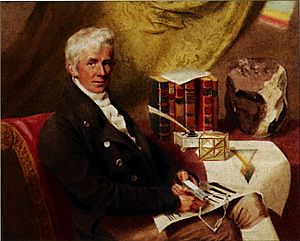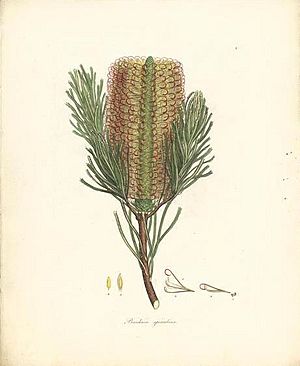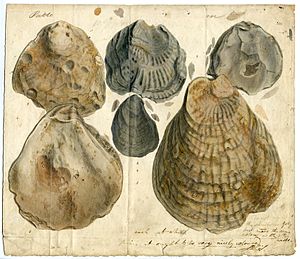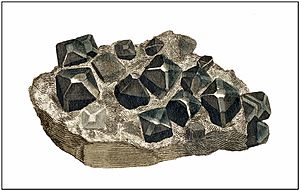James Sowerby facts for kids
Quick facts for kids
James Sowerby
|
|
|---|---|

James Sowerby painted by Thomas Heaphy (1816)
|
|
| Born | 21 March 1757 |
| Died | 25 October 1822 (aged 65) |
| Education | Royal Academy in London |
| Occupation | Illustrator, naturalist, publisher |
| Spouse(s) | Anne Brettingham De Carle |
| Children | James de Carle, George Brettingham, Charles Edward |
| Parent(s) | John Sowerby, Arabella Goodspeed |
James Sowerby (born March 21, 1757 – died October 25, 1822) was a talented English naturalist, illustrator, and expert on minerals. He created detailed and beautiful pictures for many books. These included A Specimen of the Botany of New Holland and English Botany. His use of bright colors and easy-to-understand texts helped more people learn about nature.
Contents
About James Sowerby
James Sowerby was born in Lambeth, London. His parents were John and Arabella. He decided to become an artist who painted flowers. His first job was with William Curtis, for whom he illustrated Flora Londinensis.
James studied art at the Royal Academy. He also learned from an artist named Richard Wright. He married Anne Brettingham De Carle. They had three sons: James De Carle Sowerby (1787–1871), George Brettingham Sowerby I (1788–1854), and Charles Edward Sowerby (1795–1842). These sons became part of the famous Sowerby family of naturalists.
His sons and their children continued his work. The Sowerby name became well-known for illustrating natural history.
Early Work and Big Projects
One of James Sowerby's first important jobs was for the botanist L'Hértier de Brutelle. Sowerby created the pictures for L'Hértier's book Geranologia. He also worked with William Curtis on The Botanical Magazine. Sowerby's drawings appeared in the early issues of this first British botany journal.
In 1790, Sowerby started a huge project called English Botany. This work had 36 volumes and was published over 23 years. It contained 2,592 pictures of plants, all colored by hand. People often called it Sowerby's Botany. Many plants were officially described for the first time in this book. The text was written by James Edward Smith.
Sowerby's son, James de Carle Sowerby, continued this work. He added more pictures. Other artists also contributed until 1865, bringing the total to nearly 3,000 plates.
Art and Science
James Sowerby's art was special because it combined art with natural history. He carefully described plants and animals based on real specimens and research. This was different from earlier flower paintings, which were mostly just pretty pictures.
Sowerby wanted to reach more people who were curious about gardening and nature. He made his books attractive and affordable. His beautiful hand-colored pictures also became very valuable to scientists.
His next big project was Mineral Conchology of Great Britain. This was a large catalog of many invertebrate fossils found in England. It was published over 34 years. His sons, James De Carle Sowerby and George Brettingham Sowerby I, finished the later parts. The complete work has 650 colored plates in 7 volumes.
Sowerby also developed his own ideas about colour. He published two important books on mineralogy: British Mineralogy (1804–1817) and Exotic Mineralogy (1811–1820).

James Sowerby kept the specimens he used for his books. Many famous geologists and scientists gave or lent him specimens. He hoped his collection would become a museum. He even added a room to his home to hold his collection. Important people like Joseph Banks and Charles Francis Greville visited his collection. A very popular item was the Yorkshire meteorite. This was the first meteorite found and recorded in England, in 1795.
Lasting Impact
James Sowerby's great-grandson, Arthur de Carle Sowerby, also became an explorer and naturalist. He continued the family tradition. He provided many specimens for the British Museum and other museums around the world.
James Sowerby is also remembered in the names of several plants and fungi. For example, a plant genus called Sowerbaea was named after him in 1798. A genus of fungi called Sowerbyella was named in his honor in 1938.
Key Publications
James Sowerby created many important works. Some of his projects were so big that his family members had to finish them. His illustrations and books covered many new areas of science. Besides his famous plant books, Sowerby also published works on mycology (fungi), conchology (shells), and mineralogy. He also wrote a book about his own color system. He even wrote a guide called A botanical drawing-book, or an easy introduction to drawing flowers according to nature.
Here are some of his most notable works:
- English Botany: This huge work had 36 volumes and 2,592 hand-colored pictures of British plants. It was published over 23 years.
- Coloured figures of English fungi or mushrooms: This four-volume set focused on fungi, which were not included in English Botany.
- A Specimen of the Botany of New Holland: This was the first book about the plants of Australia. Sowerby's hand-colored pictures were based on sketches and specimens brought to England.
- Zoology of New Holland: This book, illustrated by Sowerby, described animals from Australia.
- Mineral Conchology of Great Britain: A large catalog of British fossils, with 650 colored plates.
- British Mineralogy and Exotic Mineralogy: These books featured colored pictures of minerals from Britain and other parts of the world.
- A New Elucidation of Colours, Original Prismatic and Material: In this book, Sowerby presented his theory that colors are made of three basic colors: red, yellow, and blue.
Images for kids
See also
 In Spanish: James Sowerby para niños
In Spanish: James Sowerby para niños




